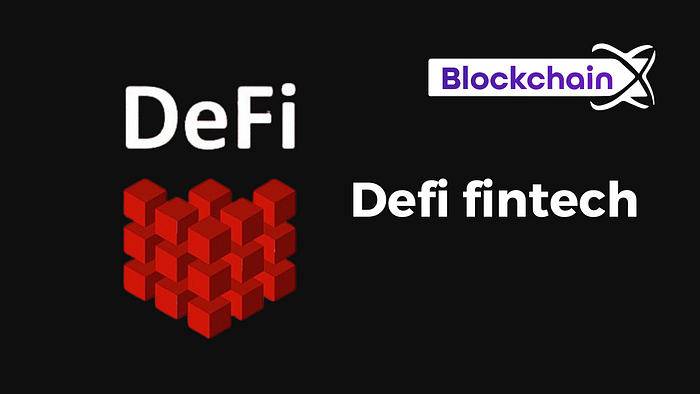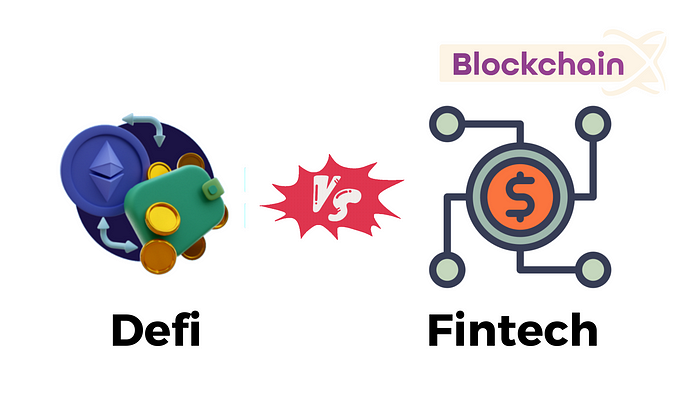To start your own DeFi (Decentralized Finance) wallet and contribute to the FinTech industry, you can follow these general steps:

Fintech and DeFi are related but distinct concepts in the realm of financial technology. Here’s an overview of their differences:
Fintech (Financial Technology): Fintech refers to the application of technology to innovate and improve various aspects of financial services. It encompasses a broad range of technologies, products, and services that aim to enhance traditional financial systems. Fintech vs defi companies leverage technology to streamline processes, enhance efficiency, increase accessibility, and provide new and innovative financial solutions. Examples of fintech applications include mobile banking apps, digital payment platforms, robo-advisors, crowdfunding platforms, and online lending services.
DeFi (Decentralized Finance): DeFi, on the other hand, is a subset of fintech that specifically focuses on leveraging blockchain technology and decentralized networks to provide financial services in a decentralized manner. DeFi aims to recreate and enhance traditional financial systems, such as banking, lending, trading, and insurance, by removing intermediaries and facilitating peer-to-peer transactions through smart contracts. DeFi platforms are built on blockchain networks, primarily Ethereum, and allow users to access various financial services directly without relying on centralized authorities or intermediaries. DeFi protocols enable features such as decentralized exchanges (DEXs), lending and borrowing platforms, stablecoins, yield farming, and automated market makers (AMMs).

Key Differences:

- Research and Understand DeFi: Gain a comprehensive understanding of DeFi and its underlying technologies, such as blockchain, smart contracts, and decentralized applications (DApps). Familiarize yourself with the different types of DeFi protocols and products available in the market.
- Identify Your Goals: Determine the specific goals and objectives you want to achieve with your defi fintech. This could include providing users with a secure and user-friendly interface, supporting a wide range of tokens and assets, or integrating with various DeFi protocols.
- Select a Blockchain Platform: Choose a suitable blockchain platform that aligns with your requirements and offers a vibrant DeFi ecosystem. Ethereum is currently the most popular platform for DeFi applications, but other platforms like Binance Smart Chain, Solana, or Polkadot might also be worth considering.
- Understand Wallet Functionality: Explore the features and functionality you wish to incorporate into your DeFi wallet. Some common features include token management, portfolio tracking, transaction history, staking and yield farming, lending and borrowing capabilities, and integration with DApps.
- Design User Experience: Pay attention to the user experience (UX) and user interface (UI) of your wallet. Strive to create an intuitive and user-friendly interface that simplifies complex DeFi operations and provides a seamless experience for users.
- Develop or Partner: Decide whether you want to develop the wallet in-house or collaborate with a third-party development team or white-label solution provider. Developing in-house allows for greater control and customization, but it requires substantial technical expertise. Partnering with an established provider can expedite the process and leverage their expertise.
- Ensure Security: Prioritize security in your wallet development process. Implement robust security measures, including encryption, two-factor authentication (2FA), multi-signature wallets, and audit your smart contracts. Regularly update and patch any vulnerabilities to safeguard user funds.
- Obtain Legal and Regulatory Compliance: Research the legal and regulatory requirements for operating a DeFi wallet in your target jurisdiction. Ensure compliance with regulations related to KYC (Know Your Customer) and AML (Anti-Money Laundering) to maintain regulatory compliance.
- Test and Launch: Thoroughly test your wallet to ensure its functionality, security, and compatibility with different devices and operating systems. Conduct both internal testing and external beta testing to gather user feedback and improve the wallet’s performance. Once you’re confident in its stability, launch your DeFi wallet and make it available to the public.
- User Support and Updates: Provide ongoing support to your users and address any issues or concerns promptly. Continuously improve your wallet’s features, security, and user experience by releasing updates and incorporating user feedback.
Fintech and DeFi are related but distinct concepts in the realm of financial technology. Here’s an overview of their differences:
Fintech (Financial Technology): Fintech refers to the application of technology to innovate and improve various aspects of financial services. It encompasses a broad range of technologies, products, and services that aim to enhance traditional financial systems. Fintech vs defi companies leverage technology to streamline processes, enhance efficiency, increase accessibility, and provide new and innovative financial solutions. Examples of fintech applications include mobile banking apps, digital payment platforms, robo-advisors, crowdfunding platforms, and online lending services.
DeFi (Decentralized Finance): DeFi, on the other hand, is a subset of fintech that specifically focuses on leveraging blockchain technology and decentralized networks to provide financial services in a decentralized manner. DeFi aims to recreate and enhance traditional financial systems, such as banking, lending, trading, and insurance, by removing intermediaries and facilitating peer-to-peer transactions through smart contracts. DeFi platforms are built on blockchain networks, primarily Ethereum, and allow users to access various financial services directly without relying on centralized authorities or intermediaries. DeFi protocols enable features such as decentralized exchanges (DEXs), lending and borrowing platforms, stablecoins, yield farming, and automated market makers (AMMs).

Key Differences:
- Centralization vs. Decentralization: Fintech solutions can involve both centralized and decentralized systems. Many fintech applications rely on centralized infrastructure, such as banks or payment processors, while leveraging technology to improve efficiency. In contrast, DeFi is built on decentralized networks, where transactions and operations are executed directly between participants without intermediaries.
- Intermediaries: Fintech often involves intermediaries such as banks, payment processors, or other financial institutions that facilitate transactions and provide services. DeFi aims to eliminate or minimize the need for intermediaries by leveraging smart contracts and decentralized protocols.
- Blockchain Technology: While fintech can utilize various technologies, DeFi specifically relies on blockchain technology. Blockchain provides a transparent, immutable, and secure infrastructure for executing and recording transactions, making it the foundational technology for DeFi applications.
- Accessibility: Fintech solutions are typically accessible to anyone with an internet connection and can be built on centralized platforms or networks. DeFi, being decentralized, defi and fintech is designed to provide financial services to a global audience, including individuals who may not have access to traditional financial systems or who prefer to maintain control over their assets without relying on intermediaries.
- Programmability: DeFi protocols are programmable, allowing developers to create complex financial applications and smart contracts that execute predefined conditions automatically. Fintech solutions may also involve automation and programmability but are not inherently built on programmable blockchain networks.
